The AlphaCool Core Storm XT45 & Core Hurrican XT45 Liquid Cooling Kits Review
by E. Fylladitakis on June 9, 2023 9:00 AM ESTTesting Results, Maximum Fan Speed
Our maximum speed testing is performed with both the fans and the pump of the kit powered via a 12V DC source. Although this voltage should have the fans matching the manufacturer’s ratings, the maximum speed of the Rise Aurora fans was 2380 RPM. Nevertheless, the speed of all five fans we tested was consistent which hints at good manufacturing and quality control.
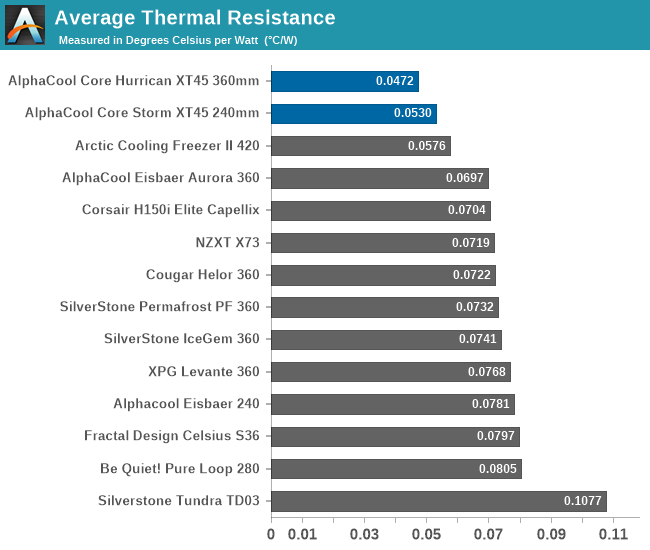
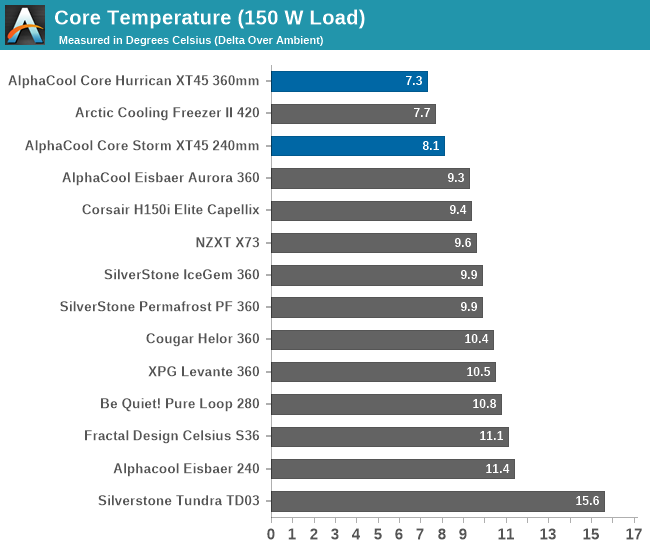
| Core Temperature, Constant Thermal Load (Max Fan Speed) |
As expected, both the Core Storm XT45 240 mm and the Core Hurrican XT45 360 mm liquid cooling kits outclass all of the typical AIO liquid cooling solutions in the market, with an average thermal resistance of 0.0527 °C/W and 0.0472 °C/W respectively. Only coolers with colossal radiators can reach comparable performance figures to the 240 mm AlphaCool kit, and even then they still cannot outperform it. Things are especially favorable for the AlphaCool kits under very low loads, with the AlphaCool Core Storm and Core Hurrican kits both destroying anything else at low load testing. It appears that AlphaCool’s CPU block design is extremely efficient at transferring thermal energy from the CPU to the circulating liquid.
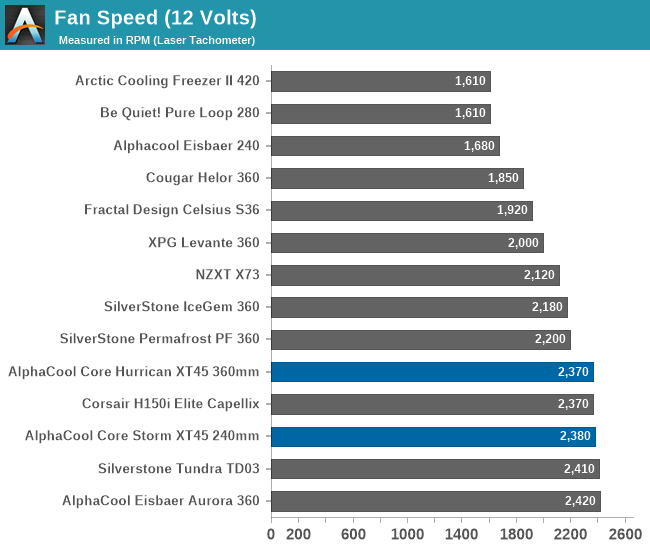
The Rise Aurora fans may be versatile but they are very powerful, which puts them into a disadvantage during acoustics testing. The Core Storm XT45 240 mm and its two fans will produce 43.7 dB(A) at maximum capacity, while the third fan of the Core Hurrican XT45 kit boosts that figure up to 45.6 dB(A). Although these figures are high for daily use, they actually are very good when the very high speed of the fans is taken into account.
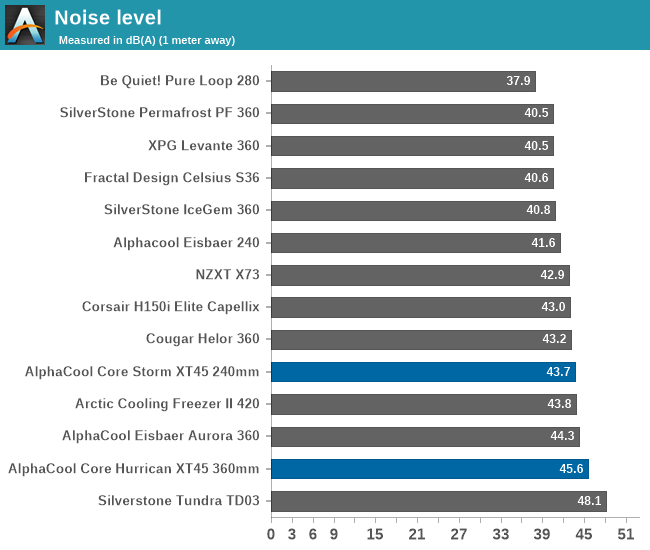
Testing Results, Low Fan Speed
Using a PWM voltage regulator, we manually reduced the speed of the fans down to half their rated speed, which is 1250 RPM for the Rise Aurora 120 mm fans. The pump was also connected on the same power source, functioning properly with this supply voltage.
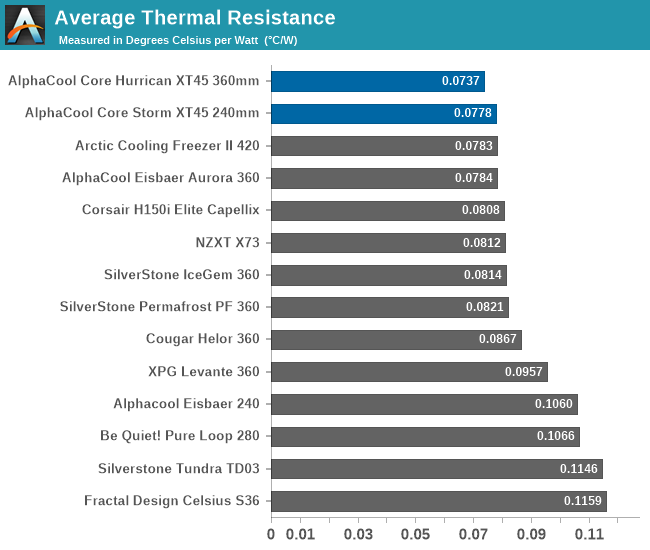
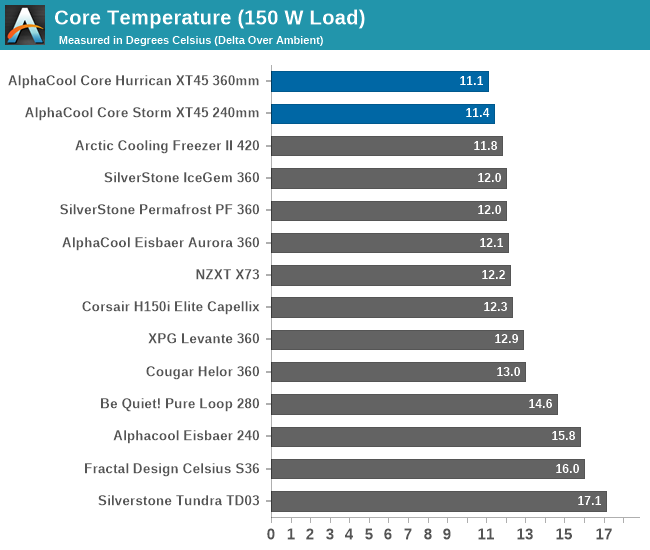
| Core Temperature, Constant Thermal Load (Low Fan Speed) |
The average thermal permittance of both kits deteriorated significantly during this test, with the Core Storm XT45 240 mm going up to 0.0778 °C/W and the Core Hurrican XT45 360 mm up to 0.0737 °C/W. Both kits still outperform typical AIO liquid coolers but it is clear that the performance impact is too severe to be attributed just to the fans. The issue was easily identifiable – the extremely wide PWM range of the fans is entirely inconsistent with the narrow 8-12V working voltage of the pump. In order for us to get the fans down to 1250 RPM, the pumps slowed down dramatically. For best performance results, the pump needs to be connected to a header with a much different cooling profile than that of the fans.
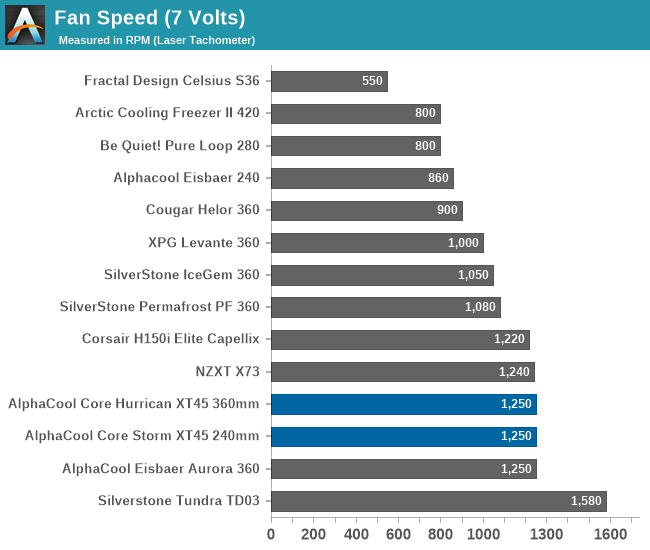
With their fans down to half their maximum rated speed, the noise output of both liquid cooling kits decreased dramatically. The AlphaCool Core Storm XT45 240 mm outputs just 34.2 dB(A), whereas the Core Hurrican XT45 360 mm is slightly louder at 35.5 dB(A). These figures are audible in a quiet room but perfectly comfortable for daily use. Nonetheless, there is plenty of headroom downwards, as the speed of the fans can be reduced much more if the user wishes. The pump itself is entirely silent, without any electromechanical noise coming out of it at any speed.
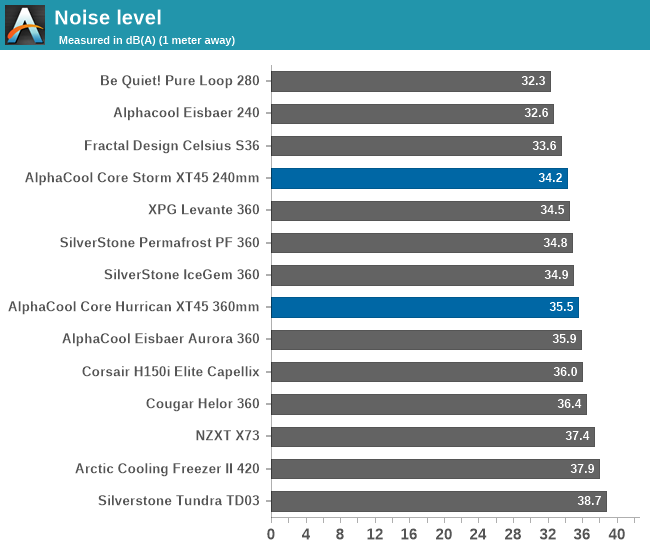
Thermal Resistance VS Sound Pressure Level
During our thermal resistance vs. sound pressure level test, we maintain a steady 100W thermal load and assess the overall performance of the coolers by taking multiple temperature and sound pressure level readings within the operating range of the stock cooling fans. The result is a graph that depicts the absolute thermal resistance of the cooler in comparison to the noise generated. For both the sound pressure level and absolute thermal resistance readings, lower figures are better.
This graph is, in our opinion, the most enlightening piece of data in this review. Not because both the Core Storm XT45 240 mm and the Core Hurrican XT45 360 mm significantly outperform everything else when the performance-to-noise ratio is taken into account, but because the slopes of their performance curves are identical. What this means is that, for the greater extent of their working range, both kits would perform exactly the same – on a single archetypal load at least, like a common modern CPU. It is only at the edges of the working range that the two kits differ, with the 240 mm kit naturally being capable of running a bit quieter and the 360 mm kit reaching a little bit lower thermal resistance figure at higher noise levels.
Ultimately, unless the load is extremely high, there would be no tangible advantage for users to opt for a 360 mm radiator. If anything, it would be a disadvantage, as it comes with the most noise.


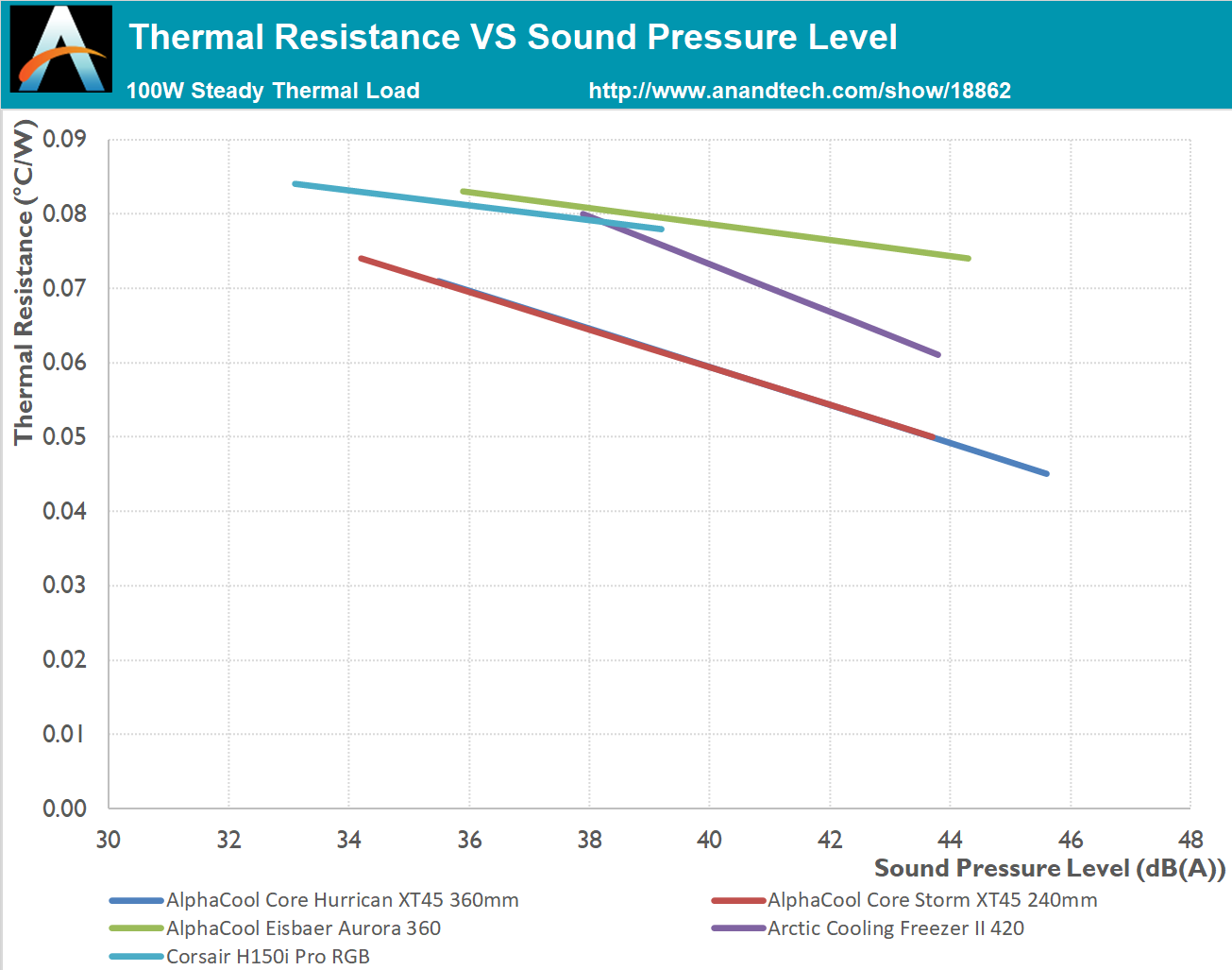








10 Comments
View All Comments
meacupla - Friday, June 9, 2023 - link
The radiators are low impedance, and fans are high air flow designs, but would that combination not work better if there were not wide open gaps between the fans?Like maybe cover the gaps up with paper board or something?
Oxford Guy - Tuesday, June 13, 2023 - link
'The nine-blade design suggests that these fans are geared more towards airflow than maximum static pressure, substantiating AlphaCool’s claims that their NexXxoS radiators have low airflow resistance.'No, it doesn't. It can very easily mean that the fans are the wrong type for the radiator. That isn't a new thing to happen with these.
zmeul - Friday, June 9, 2023 - link
I'd replace the fans with Arctic P12 MAXsparkuss - Friday, June 9, 2023 - link
Would be nice to have just a custom AIO from some of these parts with a choice of their GFX fullcover blocks. I have a case that I can hang it right next to the Roof AIO (Thermaltake Level 20 XT) currently on my CPUgarblah - Friday, June 9, 2023 - link
I'll probably never spend as much money on a CPU for a gaming build as the lower end model of these two liquid coolers cost. 5800x3d for 280 USD and a 60 dollar air cooler is where it's at.But I still like reading about how much I could be spending, and wondering what I would get out of that.
Makaveli - Friday, June 9, 2023 - link
I like their AIO for GPU's with current gen makes sense 360 Rad on something that put out 350+ watts. I have a 5800X3D also much cheaper Corsair 150 AIO on that barely needs that. If I was using a 13900K then would jump on something like this.PeachNCream - Sunday, June 11, 2023 - link
True! The least expensive of those two cooler kits is still priced at $365 which literally only gets you a cooling solution. You get no actual functional hardware and for the same price, you can get a fully working laptop with lower-end specs that can actually do useful things and have a bit left for software, accessories, and whatnot.Samus - Saturday, June 10, 2023 - link
That is a radical fin design compared to the typical heater core flat-folds used in most liquid cooling kits. Stamping and folding a sheet of fins like that without inconsistency is impressive.But everything has a trade off and this one is going to be maintenance. Keeping those fins clean and flowing sounds like a nightmare as the hooks latch onto every bit of dust passing by.
Oxford Guy - Tuesday, June 13, 2023 - link
'Copper, of course, is one of the best thermal conductors out there, but the downside is that copper is both heavy and very expensive'Does the oxidized layer also insulate significantly?
shadowx360 - Saturday, June 17, 2023 - link
Genuinely curious about the size of their target market chasing such an extreme end of the performance scale. I’d rather get an Arctic Liquid Freezer II and pocket the electricity savings of not pushing that kind of TDP.